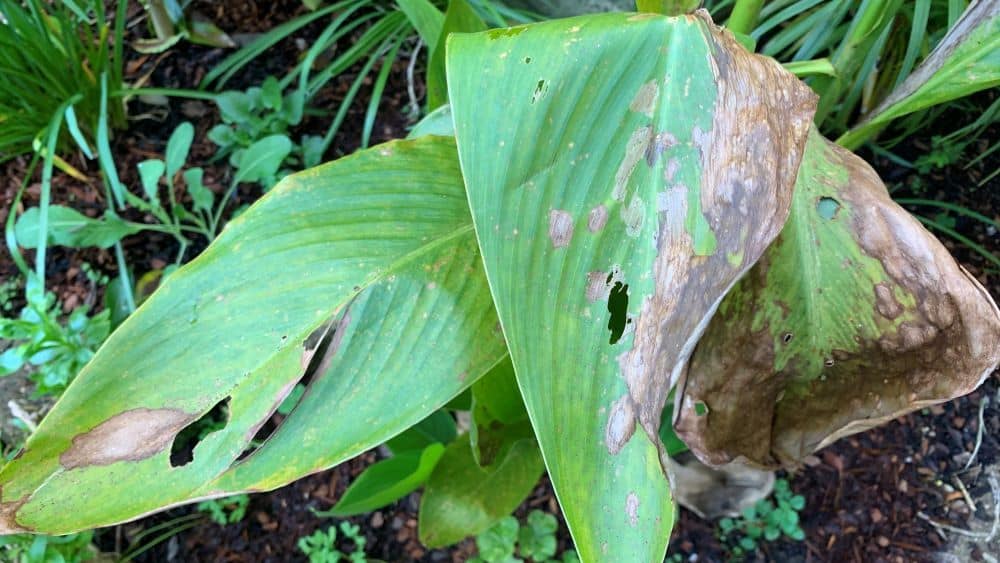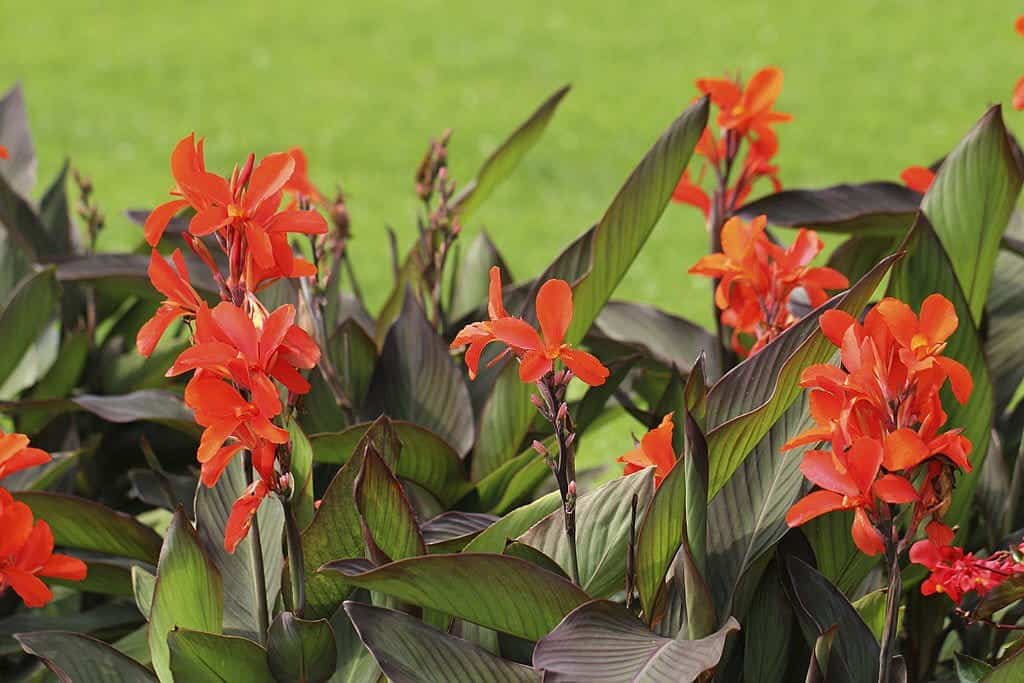Canna lily is a rhizome perennial with tropical-like foliage and large iris-like flowers. This plant is easy to grow, easy to care for, and especially the longevity of leaves and flowers is very long.
Its flowers are usually red, orange, or yellow, and the flower shape resembles a lily. So many gardeners love to grow canna lily in front of the house or in pots as an ornamental plant.
However, in the process of growing this plant, you also need to keep in mind some causes of leaves turning brown. Canna lily leaves turning brown – Is it a sign of illness or is it normal old leaves?
To find out what causes this plant’s leaves to turn brown, read on in this article.
Canna Lily Leaves Are Brown On The Edges – Why?
There are many reasons why canna lily leaves turn brown. Some common causes include leaf drop in winter, rust disease, waterlogging, insect attack, or lack of nutrients.
1. Leaves turn brown in winter
Canna lily is a plant that prefers warm temperatures, humidity, and sunshine in the summer. Therefore, this flower usually flourishes in spring and summer. They will bloom beautifully and last for a long time in the warmer months.

When the weather turns to fall or winter, the temperature will drop and the plant will hibernate like other plants. So, with the onset of fall, canna lily leaves will turn brown from the edges and the entire leaf, after which the stem also turns brown.
This is a completely normal phenomenon when the temperature is low, the leaves of this plant will turn brown, fall off and revive when spring returns. After the leaves have fallen off, you should cut the stem and leave it about 5 inches tall so that the young shoots will regrow in warm temperatures.
Don’t forget to use layers of bark, paper, or plastic wrap around the base of the tree, keeping it warm and avoiding frost.
2. Watering too much or too little water
Water is an indispensable ingredient for plant growth and development. Each plant species needs a certain amount of water at each growth period.
Canna lily will grow quickly in the warm weather of spring and summer, so it will receive ample water from the rains. Watering for this species should be checked before watering instead of periodic or fixed watering schedules.
The amount of water in the pot and in the soil of the Canna lily is also different. If you grow this flower in a pot, you will probably have to water it more often because moisture and drainage will be faster in the pot than in the ground.
Before watering, you need to check the moisture in the soil with a moisture meter or use your finger to check. If the soil is about 2 inches dry, you should water the Canna lily.
You should water slowly so that the water gradually penetrates into the soil with a large amount of water. This is called deep watering, so it can stimulate root growth to get longer and deeper in the soil.
You can water 1-2 times per week, or the number of watering times depends on rainfall, weather, or duration of drought.
Watering too little will cause plants to become dehydrated due to the rapid evaporation of leaves. In addition, high temperatures will cause leaves to brown or burn.
Too much water will cause waterlogging, which too much water will make the photosynthesis of leaves difficult. The green color will turn brown, the leaves will become soft due to the rotting of the root system.
3. Rust disease
Rust is a very common disease in Canna lily. It usually causes brown, red, or filmy spots on the leaves. This prolonged situation will cause the disease to spread to the entire leaf, then the stem, and cause this flower to wilt.
The main cause of rust development is wet leaves. A fungus that normally attacks leaves when conditions are wet, water gets on the leaves, then turns into rust.
Canna lily rust usually appears towards the end of the growing season, which is fall. Low temperatures and rain will cause humidity to rise, from which fungal spores will grow rapidly and cause rust.
To avoid the condition of fungus growing on the leaves, you need to limit watering on the leaves or regularly keep the leaves dry. Also, in the fall or winter, after the leaves have fallen, you should cut the stem and keep it only about 5 inches so it can grow back healthy when temperatures are warm.
4. Insects attack
Pests that attack leaves can cause leaves to have holes, brown, or torn edges. Worms and snails can both attack the edges of leaves and create holes in the leaves. This will cause the leaves to gradually turn brown and die.
Several other bugs such as aphids, scale, and mites can also attack the leaves of Canna lily. These insects will suck the sap of the leaf and cause it to turn brown.
For worms or snails, you can easily catch them by hand. Alternatively, you can use crushed eggshells or coffee grounds and sprinkle them around the base of the tree to prevent worms and snails from crawling onto the trunk.
For small bugs, you can use neem oil to spray the entire leaves and stem. This is a simple and effective way to get rid of pests.
5. Depriving nutrients or fertilizing too much
Canna lily is known to be a plant that can live in low nutrient conditions. However, fertilizer is still a necessary source of nutrients for the growth of Canna lily.
Lack of nutrients will also cause leaves to turn brown and fall off due to insufficient energy in photosynthesis. In addition, compaction also prevents the root system from absorbing nutrients deep in the soil. A lack of nitrogen in the soil will also cause leaves to turn brown all at once and fall off.
To limit nutritional deficiencies, you can periodically fertilize Canna lily with slow-release fertilizers or organic fertilizers. Organic fertilizers such as leaf humus, cow manure, and chicken manure all help this flower grow well.
In addition, you should not fertilize too much because fertilizer can kill plants in large amounts. From there, the leaves will turn brown and die. Make sure to apply the right amount of fertilizer for each type of plant and the time of application according to the manufacturer’s instructions.
The Last Word

Canna lily leaves will turn brown in winter like other plants when they hibernate. In addition, rust disease, too much or too little watering, pests, and improper fertilization will also cause the leaves to turn brown.
Brown spots can appear on some leaves, if not detected in time they will spread to other leaves and attack the stem. If this situation is already irreversible, remove the stem and leaves completely, keep only the healthy stem and wait for the young shoots to regrow.